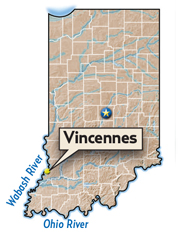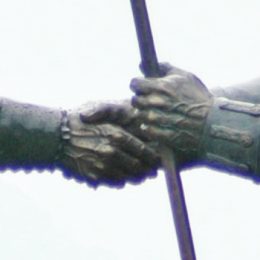 Our celebration of Indiana’s 200th birthday continues with a historic Hoosier happening that took place 37 years before Indiana ever became a state. While our neck of the woods may not immediately come to mind when talking about the American Revolutionary War, a key victory — which ultimately opened U.S. westward expansion — was won right here.
Our celebration of Indiana’s 200th birthday continues with a historic Hoosier happening that took place 37 years before Indiana ever became a state. While our neck of the woods may not immediately come to mind when talking about the American Revolutionary War, a key victory — which ultimately opened U.S. westward expansion — was won right here.
During the Revolutionary War, British forces from Detroit recaptured an outpost in Vincennes late in 1778. Founded by French fur traders in 1732, Vincennes is the oldest European settlement in Indiana.

Willie Wiredhand says be sure to visit the George Rogers Clark memorial in Vincennes where giant murals illustrate Clark’s Revolutionary War exploits — like this one of the British surrendering Fort Sackville.
Word of the British takeover soon reached George Rogers Clark, a lieutenant colonel from Virginia, who was garrisoned with his militia at an outpost south of St. Louis. Believing his small force would not be able to retake the fort once spring arrived and the Native Americans siding with the British returned from their winter homes, Clark decided on a daring, surprise attack in the dead of winter.
 In early February 1779, Clark set out with about 170 men on the 160-mile trek eastward across the frigid and flooded plains of what today we call southern Illinois. Clark and his men — cold, wet and hungry — arrived at Vincennes on Feb. 23. The town’s French residents warmly greeted Clark’s men, providing food and dry gunpowder.
In early February 1779, Clark set out with about 170 men on the 160-mile trek eastward across the frigid and flooded plains of what today we call southern Illinois. Clark and his men — cold, wet and hungry — arrived at Vincennes on Feb. 23. The town’s French residents warmly greeted Clark’s men, providing food and dry gunpowder.
While the force inside the fort’s walls consisted of about 40 British soldiers and about 40 French volunteers and militia, Clark knew it still would be tricky to get British Lt. Gov. Henry Hamilton to surrender. To fool and unnerve the British:
- Clark’s men surrounded the fort and gave the impression of having a much larger army, flying flags sufficient for an army of 500 and maintaining a rate of fire that convinced the British there were many more.
- Whenever the fort’s cannon ports opened to fire, Americans fired immediately, heavily and accurately with their long rifles trained on those openings.
- And finally, Clark ordered the executions of five Native Americans who were captured upon returning from a raiding party, sent out earlier by Hamilton to attack and kill American settlers, in full view of the fort.
Hamilton surrendered in just two days.
The surrender represented much more than just taking a little one-acre fort on the frontier. Clark’s victory here and continued disruption of the British throughout the rest of the war changed the dynamics of the western frontier.
At the 1783 peace negotiations in Paris, which officially ended the war, the British wanted the new north/south boundary between British and American holdings to be the Ohio River. However, with Clark’s conquest at Fort Sackville, north of the Ohio, the American negotiating team of John Jay, Benjamin Franklin and John Adams succeeded in moving the boundary to the Great Lakes. Thus the Northwest Territory was created as a part of the newly-formed United States. That territory now includes Ohio, Indiana, Illinois, Michigan, Wisconsin and eastern Minnesota.
The fort’s exact location in Vincennes is not known, but it is believed the fort was on the grounds of the present-day George Rogers Clark National Historical Park which honors Clark and his men.
After the war, Clark retired to land he received as payment for his military service overlooking the Falls of the Ohio River — in what today is the town that bears his name, Clarksville.
For more information, visit www.nps.gov/gero.
Stay tuned each month as Willie presents more Indiana “Bicentennial Zingers.”



